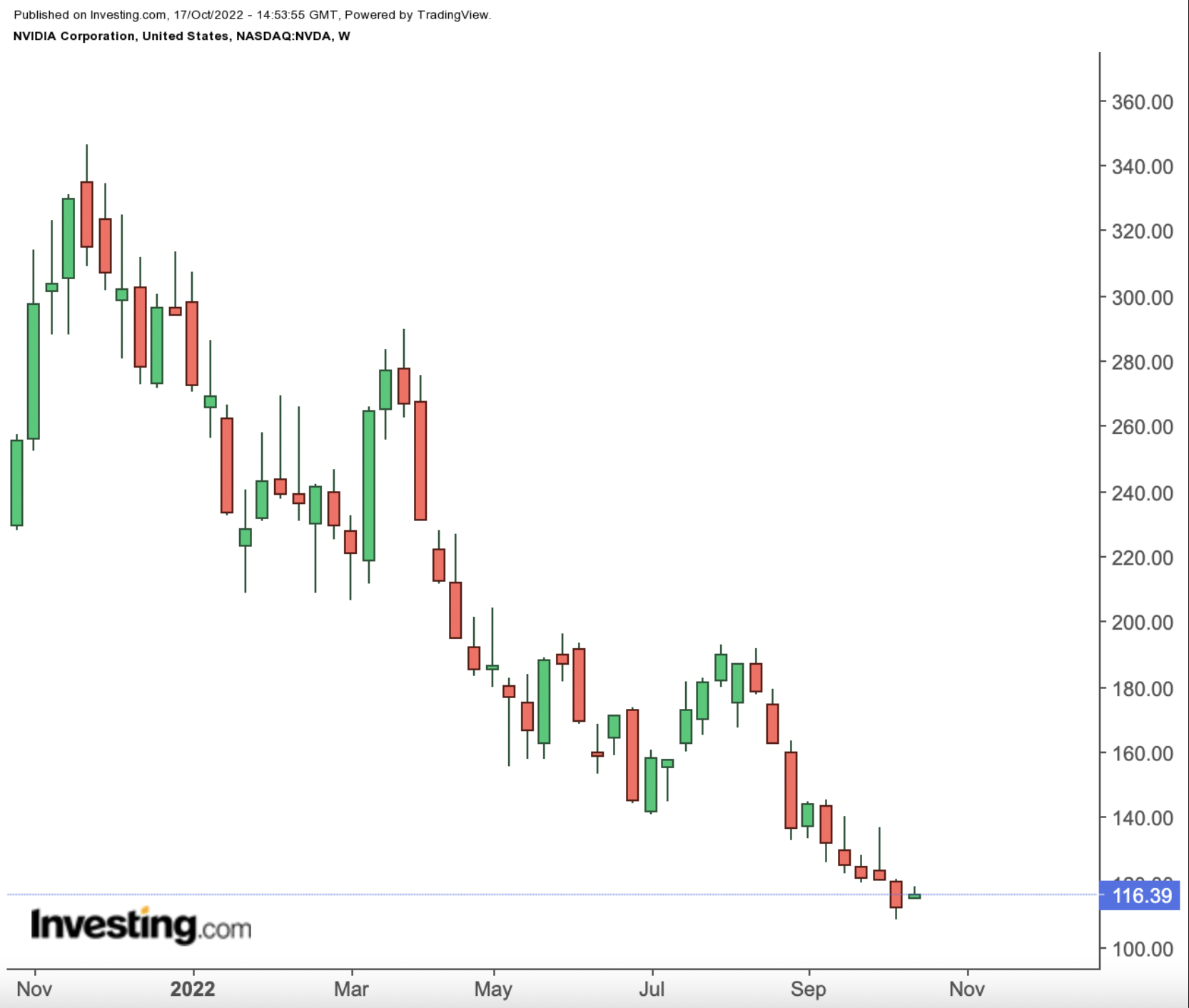- Semiconductor bulls believed the chip cycle had come to an end. That no longer appears to be the case
- Plunging demand hitting near-term performance and colors past results
- NVDA is down 68% from its 52-week high, but in context of the cycle, shares don’t look cheap
For decades, semiconductor stocks generally traded at a discount to the overall market. The issue was simple: the industry was intensely cyclical.
Increased demand for certain chips would lead to higher pricing and greater earnings. Producers would respond by building out capacity. When demand inevitably pulled back, that higher supply would lead prices to plunge, and profits would head south.
Add in the relatively quick obsolescence of many semiconductor designs, and investors couldn’t trust the consistency of industry profits. As a result, they generally applied a lower multiple to those profits than they might for other companies that had the ability to grow earnings for years, if not decades.
In recent years, however, that perception started to change. One of the biggest beneficiaries of the new perspective was Nvidia (NASDAQ:NVDA). For years, the cutting-edge developer saw its shares trade at a premium to tech stocks, let alone the market as a whole.
One of the core reasons for that premium was a belief that, for the industry as a whole and for Nvidia specifically, the cyclical nature of the business was fading. Semiconductor applications exploded with the advent of the Internet, connected devices and many other trends.
For Nvidia itself, data center and gaming growth promised years of increased demand. And the company’s competitive dominance — Nvidia still has an estimated 80% market share in graphics processing units (GPUs) — suggested that the company could and would take advantage of that demand.
And so in a sector with compressed multiples, NVDA often traded at 40x forward earnings or more. As recently as November, when NVDA hit an all-time high, shares were valued at more than 70x fiscal 2022 (ending January) earnings.
Then the cycle struck.
Tough Quarters Ahead
As it turns out, Nvidia was a pandemic winner. With out-of-home spending curtailed in 2020 and 2021, many consumers instead splurged on high-end gaming systems powered by Nvidia cards. Supply-chain constraints boosted pricing, improving profit margins.
Amid the return to normalcy, demand has plunged. And the problem has been exacerbated by a flood of used GPUs from Ethereum miners as that cryptocurrency has transitioned to “proof-of-stake” instead of “proof-of-work.”
While the cause is historically unusual, the impacts echo those seen in past semiconductor cycles. Pricing is coming down along with demand, eroding Nvidia’s profit margins. In the second quarter, Nvidia’s revenue growth slowed to just 3% year-over-year. But gross profit margins, even on an adjusted basis, plunged 20.8 percentage points to 45.9%. Adjusted operating income fell by more than half.
Q3 looks even worse. Nvidia is guiding for revenue to decline about 17% versus the prior-year quarter. Gross margins are expected to recover, as Nvidia slows shipments rather than discounting to move product. Even so, guidance implies a 40% decline in operating income year-over-year.
This isn’t necessarily a two-quarter problem, either. It will take some time for existing inventories, both used and new, to be worked through. Macroeconomic pressures could keep a lid on demand as well. Rival Advanced Micro Devices (NASDAQ:AMD) is providing real competition in GPUs in a way it didn’t even a few years ago, and may decide to keep its production intact in a bid to take more market share.
Ideally, Nvidia will get through this rough patch and back to growth. For the moment, Wall Street expects it will: the consensus earnings per share estimate for fiscal 2024 is about even with FY22 results. But there’s no guarantee a rebound is on the way.
Looking Backwards
That’s particularly true because, in hindsight, results for FY21 and FY22 look like they benefited from Nvidia over-earning in a hugely beneficial environment. Supply-chain problems were an issue, but that aside demand was about as high as it will ever be. Data centers were being built out at a frenzied pace, consumers were flush worldwide, and crypto demand boomed.
If the cycle is at play now, it was at play then. That, in turn, colors, to at least some extent, the company’s rapid growth in recent years. Obviously, that’s not to say Nvidia did nothing right, or that hugely impressive performance — revenue increased 147% in two years between FY20 and FY22 — was solely due to outside factors. Still, to some extent those outside factors did benefit performance.
In that context, even down 68% NVDA stock does not look particularly cheap. It’s a cyclical name trading at 25 times what look like peak earnings. Even assuming long-term growth opportunities, that’s not a multiple that screams “cheap.”

Source: Investing.com
And while the stock is down 68% from the highs, the stock’s multi-year gains still price in some of the broader, long-term tailwinds. Since the beginning of 2020, NVDA has rallied 91%. Over five years, it’s gained 127%; over a decade, an astonishing 3,310%.
It’s tempting to argue that NVDA is “cheap” because it has fallen since November. But that’s no more accurate than arguing that it’s “expensive” since it has soared since 2012. Investors need to look at the business as it stands now.
And there are real concerns here in terms of just how profitable this company actually is in a normalized environment. And, in turn, what valuation still looks like on an earnings basis. After all, Nvidia still has a market capitalization just shy of $300 billion. Historically speaking, that remains an outlier.
Disclaimer: As of this writing, Vince Martin has no positions in any securities mentioned.
